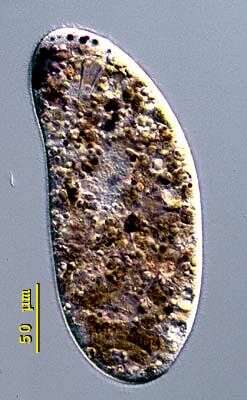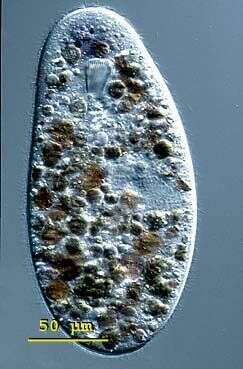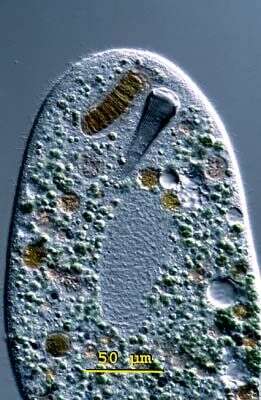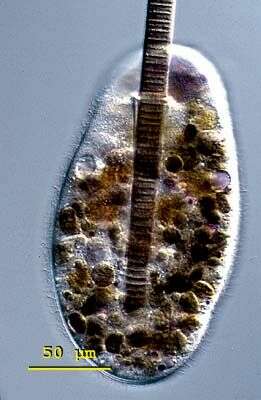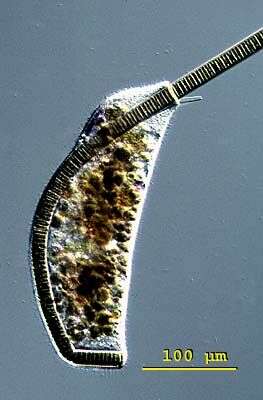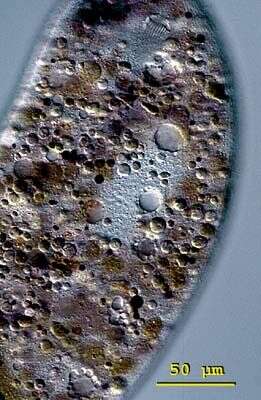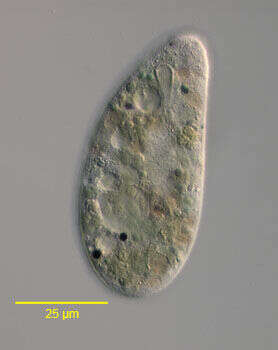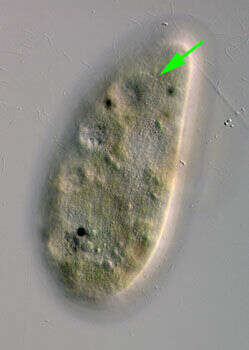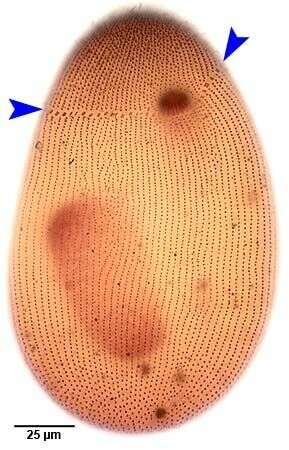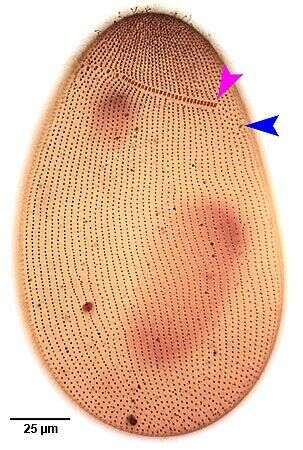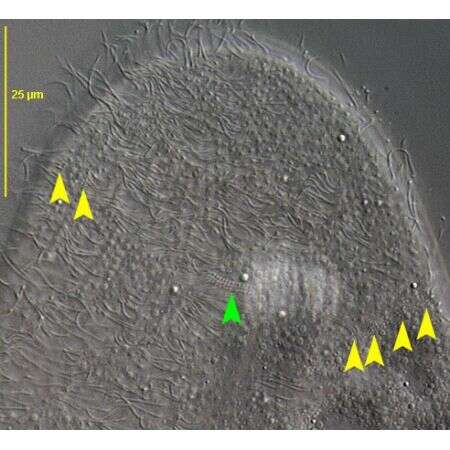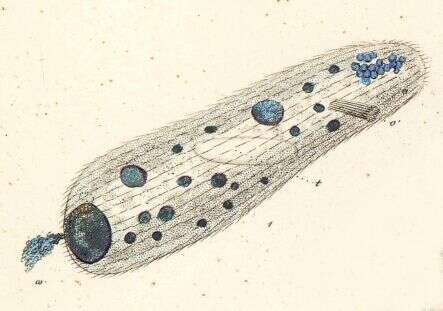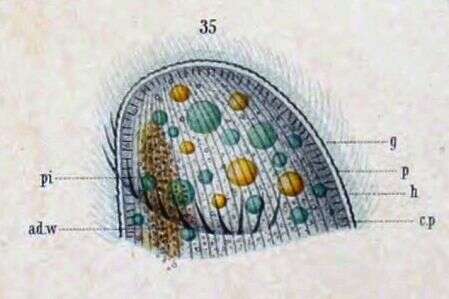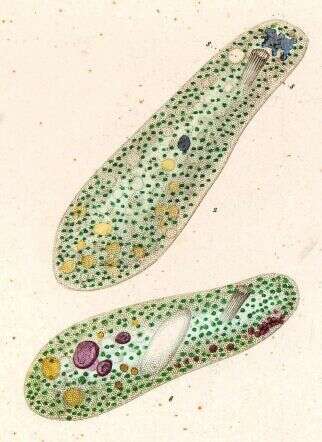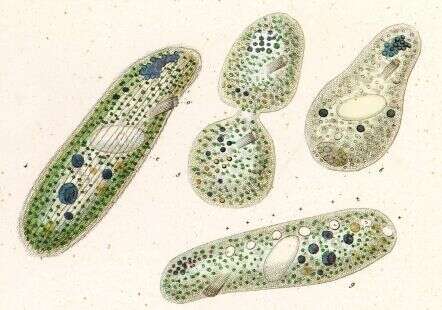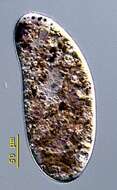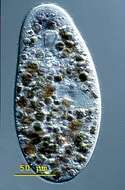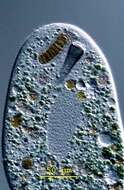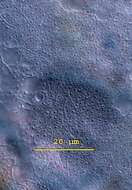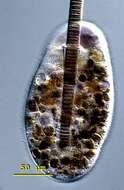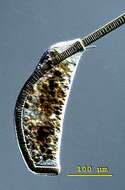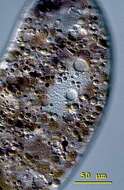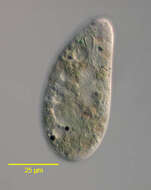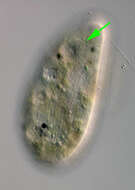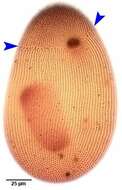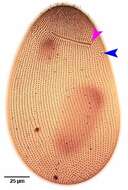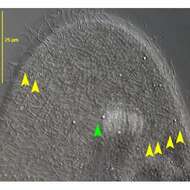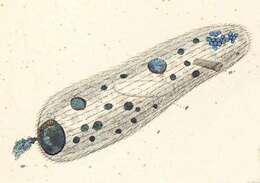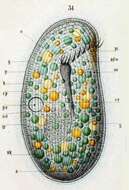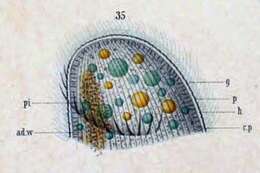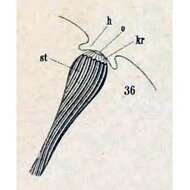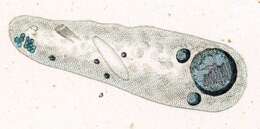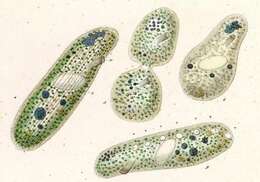-
Nassulopsis (nass-you-lop-sis). Nassulopsis elegans is a conspicuous pink- or blue coloured nassulid found in pond and lake plankton. This cell was collected from floating colonies of Oscillatoria in a freshwater pond near Konstanz, Germany. The body is cylindrical in shape and measures 150 - 300 X 50 - 100 microns. Nassulopsis can be distinguished from Nassula and Obertrumia by 5-7 contractile vacuoles arranged in a ventral row. The macronucleus is cylindrical with rounded ends. The cytopharyngeal basket is located in the anterior third of the cell. The cells fill up with food vacuoles of different colour (green, orange), depending on stage of digestion. Free-swimming cell, 250 microns long. Differential interference contrast.
-
Nassulopsis (nass-you-lop-sis). Nassulopsis elegans is a conspicuous pink- or blue coloured nassulid found in pond and lake plankton. This cell was collected from floating colonies of Oscillatoria in a freshwater pond near Konstanz, Germany. The body is cylindrical in shape and measures 150 - 300 X 50 - 100 microns. Nassulopsis can be distinguished from Nassula and Obertrumia by 5-7 contractile vacuoles arranged in a ventral row. The macronucleus is cylindrical with rounded ends. The cytopharyngeal basket is located in the anterior third of the cell. The cells fill up with food vacuoles of different colour (green, orange), depending on stage of digestion. Slightly flattened cell, 260 microns long. Differential interference contrast.
-
Nassulopsis (nass-you-lop-sis). Nassulopsis elegans is a conspicuous pink- or blue coloured nassulid found in pond and lake plankton. This cell was collected from floating colonies of Oscillatoria in a freshwater pond near Konstanz, Germany. The body is cylindrical in shape and measures 150 - 300 X 50 - 100 microns. Nassulopsis can be distinguished from Nassula and Obertrumia by 5-7 contractile vacuoles arranged in a ventral row. The macronucleus is cylindrical with rounded ends. The cytopharyngeal basket is located in the anterior third of the cell. The cells fill up with food vacuoles of different colour (green, orange), depending on stage of digestion. The cytopharyngeal basket is anterior. To the right of the basket is an ingested cyanobacteria. Below the basket an ovoid-shaped macronucleus is visible. Differential interference contrast.
-
Nassulopsis (nass-you-lop-sis). Nassulopsis elegans is a conspicuous pink- or blue coloured nassulid found in pond and lake plankton. This cell was collected from floating colonies of Oscillatoria in a freshwater pond near Konstanz, Germany. The body is cylindrical in shape and measures 150 - 300 X 50 - 100 microns. Nassulopsis can be distinguished from Nassula and Obertrumia by 5-7 contractile vacuoles arranged in a ventral row. The macronucleus is cylindrical with rounded ends. The cytopharyngeal basket is located in the anterior third of the cell. The cells fill up with food vacuoles of different colour (green, orange), depending on stage of digestion. This picture shows the pellicle of Nassulopsis elegans with its net like ornamentation. A mucocyst lies at the centre of each square. Differential interference contrast.
-
Nassulopsis (nass-you-lop-sis). Nassulopsis elegans is a conspicuous pink- or blue coloured nassulid found in pond and lake plankton. This cell was collected from floating colonies of Oscillatoria in a freshwater pond near Konstanz, Germany. The body is cylindrical in shape and measures 150 - 300 X 50 - 100 microns. Nassulopsis can be distinguished from Nassula and Obertrumia by 5-7 contractile vacuoles arranged in a ventral row. The macronucleus is cylindrical with rounded ends. The cytopharyngeal basket is located in the anterior third of the cell. The cells fill up with food vacuoles of different colour (green, orange), depending on stage of digestion. This picture shows the mouth and an anterior pigment spot consisting of 20 - 50 vacuoles filled with strongly coloured blue or violet oil. Differential interference contrast.
-
Nassulopsis (nass-you-lop-sis). Nassulopsis elegans is a conspicuous pink- or blue coloured nassulid found in pond and lake plankton. This cell was collected from floating colonies of Oscillatoria in a freshwater pond near Konstanz, Germany. The body is cylindrical in shape and measures 150 - 300 X 50 - 100 microns. Nassulopsis can be distinguished from Nassula and Obertrumia by 5-7 contractile vacuoles arranged in a ventral row. The macronucleus is cylindrical with rounded ends. The cytopharyngeal basket is located in the anterior third of the cell. The cells fill up with food vacuoles of different colour (green, orange), depending on stage of digestion. This image shows a specimen of Nassulopsis elegans beginning to ingest Oscillatoria. The cyanobacteria measures 18 (m in diameter. Differential interference contrast.
-
Nassulopsis (nass-you-lop-sis). Nassulopsis elegans is a conspicuous pink- or blue coloured nassulid found in pond and lake plankton. This cell was collected from floating colonies of Oscillatoria in a freshwater pond near Konstanz, Germany. The body is cylindrical in shape and measures 150 - 300 X 50 - 100 microns. Nassulopsis can be distinguished from Nassula and Obertrumia by 5-7 contractile vacuoles arranged in a ventral row. The macronucleus is cylindrical with rounded ends. The cytopharyngeal basket is located in the anterior third of the cell. The cells fill up with food vacuoles of different colour (green, orange), depending on stage of digestion. This image shows a specimen of Nassulopsis elegans elongated and deformed by ingesting a cyanobacteria (Oscillatoria).. Differential interference contrast
-
Nassulopsis (nass-you-lop-sis). Nassulopsis elegans is a conspicuous pink- or blue coloured nassulid found in pond and lake plankton. This cell was collected from floating colonies of Oscillatoria in a freshwater pond near Konstanz, Germany. The body is cylindrical in shape and measures 150 - 300 X 50 - 100 microns. Nassulopsis can be distinguished from Nassula and Obertrumia by 5-7 contractile vacuoles arranged in a ventral row. The macronucleus is cylindrical with rounded ends. The cytopharyngeal basket is located in the anterior third of the cell. The cells fill up with food vacuoles of different colour (green, orange), depending on stage of digestion. This image shows a compressed specimen of Nassulopsis elegans with a view of a row of contractile vacuoles. Differential interference contrast.
-
Ventral view of the nassulid ciliate, Nassulopsis elegans (Ehrenberg,1833)Foissner,1994.Collected from a freshwater pond near Boise, Idaho.DIC.
-
Surface view of the nassulid ciliate,Nassulopsis elegans(Ehrenberg,1833)Foissner,1994. There is a transverse hypostomial frange (synhymenium) of polykinetids which nearly encircles the anterior end of the cell (green arrow).Each element of the frange consists of 6-9 basal bodies.Collected from a freshwater pond near Boise, Idaho.DIC.
-
Ventral infraciliature of Nassulopsis elegans (EHRENBERG,1833) FOISSNER,1994. The synhymenium (blue arrowheads) is composed of 60-75 small nassulid organelles. It spans the ventral surface and wraps around on the right and left side of the dorsal surface leaving only a small gap between the right and left ends. Collected from the slow-moving runoff of a freshwater pond near Boise, Idaho.Stained by the silver carbonate technique (Foissner,W. Europ. J. Protistol.27:313-330;1991).Brightfield.
-
Dorsal infraciliature of Nassulopsis elegans (EHRENBERG,1833) FOISSNER,1994. The synhymenium is composed of 60-75 small nassulid organelles. It spans the ventral surface and wraps around on the right and left side of the dorsal surface leaving only a small gap between the right (pink arrowhead) and left ends (blue arrowhead). The dorsal component of the synhymenium is composed of more closely spaced nassulid organelles.Collected from the slow-moving runoff of a freshwater pond near Boise, Idaho.Stained by the silver carbonate technique (Foissner,W. Europ. J. Protistol.27:313-330;1991).Brightfield.
-
Dorsal view of the nassulid ciliate, Nassulopsis elegans (Ehrenberg,1833)Foissner,1994.The yellow arrowheads indicate nassulid organelles composed of two rows with three basal bodies each.The green arrowhead indicates the dorsal terminus of the left part of the synhymenion consisting of about seven more closely spaced nassulid organelles.Collected from a freshwater irrigation canal near Boise,Idaho.DIC.
-
Originally described by Ehrenberg under the name Nassula elegans.
-
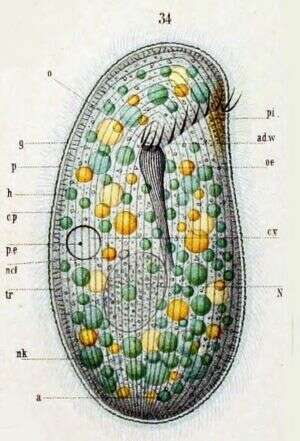
Originally described by Schewiakoff under the name Nassula elegans. Although the species Nassula elegans Ehrenberg has been transferred to the genus Nassulopsis Faure-Fremiet, 1959 (Foissner, 1994), the organism described and illustrated by Schewiakoff under the original name does not meet all the morphological criteria for the new taxonomic placement (multiple contractile vacuoles, hypostomial frange that spans the ventral face). Schewiakoff is very firm on the presence of only one contractile vacuole in all his specimens, and his illustration of the frange is unambiguous. It seems likely, then, that his Nassula elegans was, in fact, a malnourished variety of Nassula ornata, as described by Edna McNally (Biol. Bull. October 1, 1926 vol. 51 no. 4 237-244 ). Key to Schewiakoff's abbreviations: a -- Anus ad. w -- Adoral ciliated zone cp -- Cortical plasma cv -- Contractile vacuole g -- Gelationous layer h -- Ectoplasm of a homogenous appearance oe -- Throat N -- Macronucleus ncl -- Micronucleus nk -- Food particle o -- Mouth p -- Pellicle pe -- Excretory pore of the contractile vacuole pi -- Pigmented spot tr -- Trichocysts
-
Originally described by Schewiakoff under the name Nassula elegans. Although the species Nassula elegans Ehrenberg has been transferred to the genus Nassulopsis Faure-Fremiet, 1959 (Foissner, 1994), the organism described and illustrated by Schewiakoff under the original name does not meet all the morphological criteria for the new taxonomic placement (multiple contractile vacuoles, hypostomial frange that spans the ventral face). Schewiakoff is very firm on the presence of only one contractile vacuole in all his specimens, and his illustration of the frange is unambiguous. It seems likely, then, that his Nassula elegans was, in fact, a malnourished variety of Nassula ornata, as described by Edna McNally (Biol. Bull. October 1, 1926 vol. 51 no. 4 237-244 ). Anterior, dorsal view. Key to Schewiakoff's abbreviations: ad.w -- Adoral ciliated zone c.p -- Cortical plasma g -- Gelatinous layer h -- Plasma of a homogeneous appearance. p -- Pellicle pi -- Pigmented spot
-
Originally described by Schewiakoff under the name Nassula elegans. Detail of cytopharyngeal ""eel basket,"" from the side. Although the species Nassula elegans Ehrenberg has been transferred to the genus Nassulopsis Faure-Fremiet, 1959 (Foissner, 1994), the organism described and illustrated by Schewiakoff under the original name does not meet certain morphological criteria for the new taxonomic placement (multiple contractile vacuoles, hypostomial frange that spans the ventral face). Schewiakoff is very firm on the presence of only one contractile vacuole in all his specimens, and his illustration of the frange is unambiguous. It seems likely, then, that his Nassula elegans was, in fact, a malnourished variety of Nassula ornata, as described by Edna McNally (Biol. Bull. October 1, 1926 vol. 51 no. 4 237-244 ). h -- Ectoplasm of homogeneous appearance o -- Mouth kr -- Plasmatic collar of the rod system st -- Cytopharyngeal basket
-
Originally described by Ehrenberg under the name Nassula elegans.
-
Originally described by Ehrenberg under the name Nassula elegans.
-
Originally described by Ehrenberg under the name Nassula elegans.


